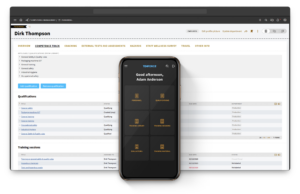Skills Matrices: The Secret to EHSQ Success
Operational success thrives on the certainty that your team is equipped with the essential skills. Whether it’s upholding safety standards, preserving top-quality standards, or streamlining operational efficiency, the skills and qualifications of your workforce are key to a successful EHSQ program.
That’s where skills matrices come in. They’re instrumental in assessing your team’s competencies and individual skills, allowing you to spot any skill gaps and implement targeted training programs.
Keep reading for a detailed step-by-step guide on how to establish them, along with an essential introduction to the indispensable tool you’ll need for the job.
Building a competency inventory
Let’s start with the basics. A skills matrix is a visual representation of the skills needed for specific job roles or tasks within your workplace, along with your team’s proficiency in those areas. This valuable tool provides a comprehensive overview of the skills within your organization, enabling you to spot individual strengths and team-wide competencies, pinpoint skill gaps, and plan training.
Only by taking stock of existing skills can you gain a deeper insight into your team’s capabilities and identify and rectify skill gaps.
Safeguarding success in EHSQ programs
Skills matrices are the driving force behind competence management, serving as an essential tool for decision-making and strategic planning. They not only reveal skill gaps but also encourage personal development among your team. Employees can assess their proficiency levels, identify the skills they need for progress, and stay motivated to acquire new skills. For team leaders, these matrices provide a clear picture of the team’s strengths, skill gaps, and training needs.
The benefits stretch beyond competence management, extending their reach into other areas of your EHSQ program. By making sure your team has the right skills and knowledge, skills matrices prevent workplace accidents and ensure compliance with industry standards and regulations, mitigating the risk of fines, legal repercussions, and reputational damage.
Skills matrices: a step-by-step guide
So, how do begin generating those all-important skills matrices? Let’s break it down into four simple steps:
- Define Proficiency Levels: First things first, identify the skills your organization needs. For each skill, determine its proficiency level and how you’re going to measure it. This sets the stage for your skills matrix and provides a clear path for everyone to follow.
- Choose Your Matrix Style: Choose the matrix style that best suits your needs. It could be all about the actual skills held by your team members, it could track proficiency levels, or even dive into gap analysis for that extra depth.
- Implement Training Programs: Once you’ve got those insights in hand, it’s time to put them into action. Plan out new training courses for your team and track their progress through them.
- Monitor and Improve: Keep tabs on the impact of your training programs. Continuous improvement is the name of the game. So, monitor the changes, see how they work, and tweak as needed.
Excel or Competence Management software?
Spreadsheets might seem like a convenient tool for skills matrices – everyone knows their way around them, templates are readily available, and they don’t add extra costs. But when it comes to dealing with the complexity of the task, especially within an organization with numerous jobs, roles, tasks, and skills, spreadsheets can start hitting roadblocks.
Sooner or later, you’re bound to encounter one or more of the familiar drawbacks linked with spreadsheets, such as proneness to errors, inadequate version control, absence of distinct authorization levels, lack of real-time data insights, difficult manageability, and tricky template updates.

With TenForce’s Competence Management, you gain a centralized platform to oversee skills matrices and training programs. Here’s what you can do:
- Integrate various data sources to consolidate competency-related information. This enables you to create comprehensive reports on skills, competencies, and workforce capabilities, enhancing your strategic decision-making.
- Tailor matrices to align with your organizational needs, roles, and industry standards. Automate competency mapping for easy identification of skill gaps and seamless planning of targeted training programs.
- Initiate training programs, track employee progress, and schedule additional certifications, ensuring your workforce stays equipped with the necessary skills.
- Benefit from regular updates to meet industry regulations and standards. Align skills matrices with specific regulatory requirements, reducing compliance risks effectively.
What’s next? Watch our expert-led demo
Your team’s skills are the bedrock of a successful EHSQ program. To unlock their full potential, it’s time to implement Competence Management software. This step will streamline operations, empower your workforce, and lead to improved safety, enhanced quality, and increased operational efficiency.
Curious to learn more? Watch our on-demand webinar for a hands-on demonstration of TenForce’s Competence Management. You’ll learn how to:
-
- Keep track of the diverse skills necessary in your workplace.
- Maintain a centralized overview of your employees’ skill sets.
- Monitor competency progression through real-time analysis and advanced dashboards.
- Strategically plan and implement employee training.
